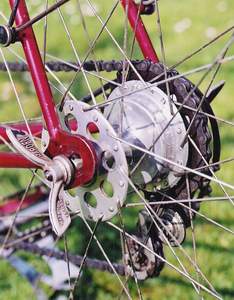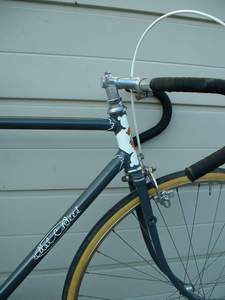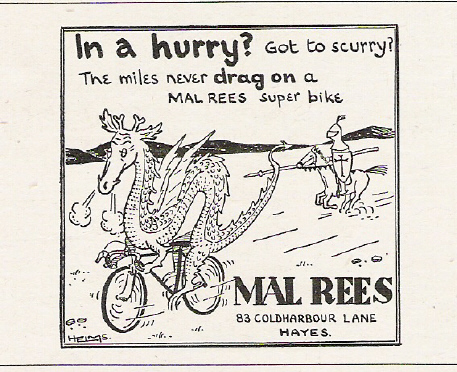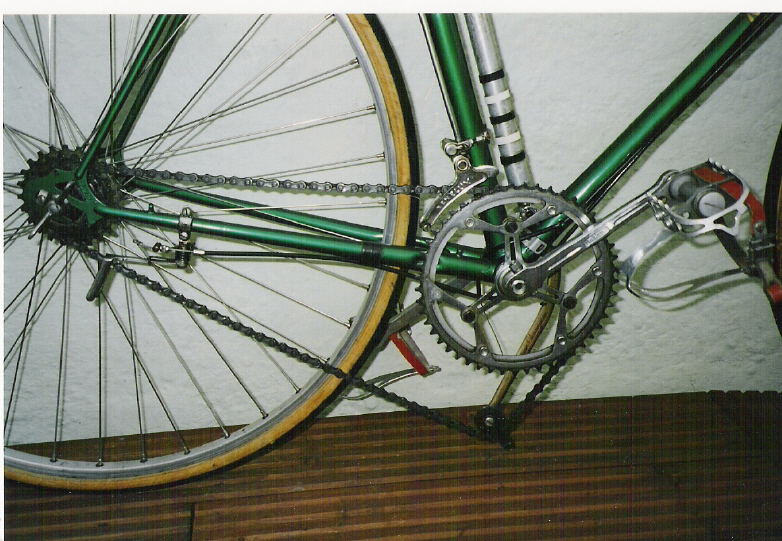Vol. 2, Issue 3 - May / Jun 2006
Posted: Thursday 25th May 2006
Saddle height on older machines. If you look at catalogues, or pictures of riders taken with their machines, in the 50s you will notice a big difference compared to modern-day set-ups. The fashion back then was to have a mere inch or two of seat pillar showing with the stem almost level with the saddle. Pictures of Eileen Sheridan’s bikes show this very well. See Boneshaker 170, Spring 2006 p.33 for example. Riders like Eileen didn’t have much option as it was quite rare to get a frame made with less than a 21” seat-tube. On the other hand, taller riders couldn’t conform to this fashion as it was also very rare to get a frame built which was more than 24”. We all know that there were exceptions to this but the number of builders making 25” or even 26” frames was very small – they are about but AVT, Terry Blake and Peter Salmon have got this market cornered!.
Being six feet tall I suffered from having several inches of seat pin showing at all times and I used to look longingly at riders who were able to have the modish set-up. Ironically, this was at a time when virtually all serious cyclists had ‘custom built’ hand-tailored frames! Patricia was telling Eileen Sheridan about her modern 17 ½” frames with short top tubes and Eileen said she would have given her right arm for one back in the 50s. The problem in those days was of course the restrictions imposed on builders by the use of lugs: even their welded frames were replicas of the lugged designs. Frame builders never ‘thought outside the box’.
Some pictures of Coppi and Bartoli show their stage racing machines with the stem as high as, or higher, than the nose of the seat. Compare this with today when equivalent ‘Tour’ riders have the seat set at what looks like 6” – 8” above the bars.
One consequence of these factors was that in the 50s riders spent much more time ‘on the drops’, time-triallists only having one brake lever most of the time in this country. Nowadays with padded bars and two levers it is more comfortable ‘on the tops’ and it is not uncommon to see riders spend most of the day in this position, even when the screws are being turned. Time triallists excepted of course but that is another story in itself. It also had consequences for bars and stems: the ‘level set-up’ restricted the positions open to the rider as his stem was already as low as it would go. Component manufacturers came to the rescue here with sloping, droopy and Major Taylor stems which enabled fast men to get their bars lower.
These stems were mated to bars, some of which had serious drop built in. Looking at Eileen Sheridan’s end to end machine makes one wonder where they got bars with so much drop – they could have been modified just for her – even clubmen did this to their bars. I wondered why they didn’t lower the stem and use more conventional bars but maybe it was to give a restful position ‘on the tops’ – after all she had 1000 miles to go!
Lorries in the 50s were speed-governed and underpowered compared with the monsters on the road today. Amongst the less well-behaved riders (Guilty me-Lud) there was quite a habit of ‘lorry jumping’ as it was known. If you were alone, or with say one other rider, faced with a stiff head-wind home it was relatively easy to jump in behind a lorry as it lumbered past at 20mph. In those days lorries had very primitive braking systems so there was no chance of piling into the back if it were to brake suddenly, even though we were on fixed with one ineffective GB brake. Naughty lorry drivers used to knock out of gear on the downhill stretches so they could coast faster than using the governed drive. There was lot of twiddling done on these stretches but if you did lose contact for a while it was possible to catch up on the next hill.
I recently managed to check out all editions of the short-lived East Anglian Cyclist and was interested in the show report for 1948 which I believe was the first after WW2 and had staggering attendances. Practical Mechanics January 1949 says that there were 70,000 visitors on the Saturday – yes 70,000! The E A C contributor ‘Tecmec’ (Mick Madgett’s father, Eric?) gave a list of frames produced by Carpenter of Kingston in Surrey. They included BAR Shortmarker’s Special; Ace Continental; Super Club with a Supalite displayed as a track machine.
Tecmec also noted the Six-Day track model on the Hetchins stand which had the fluted seat tube to allow a shorter rear triangle without resorting to twin tubes or a bent seat tube. There are still some of these fluted frames in circulation. I went years without seeing one and then saw two in a weekend – I guess it must have been the Hetchins W E.
Bates were showing the B.A.R.; Vegrandis; Volante and Vendome Continental models. It was said that the latter was the re-introduction of a famous pre-war Belgian-made cycle which was now made in this country! It was fitted with a QR Italian rear hub which allowed the rear wheel to be removed whilst leaving the sprockets and chain in situ.
Granby, it states were now being made by a new firm and included taper-tube models and rear ends with Granby’s own patent chain adjusters. They also displayed their own brand of alloy cranks with the flutes painted to match the frames.
TecMec went on to review accessories and it interesting that he says Constrictor had the Osgear as 3, 4 and 5-speed on show, although the 4 and 5 were not yet available to the public. I have met enthusiasts who say that there was no such thing as a 5-speed Osgear, insisting that they are all conversions. Chater were showing their new round cranks available in limited quantities for the home market, whereas the square version of the cranks were for export only at this time. Lytaloy were also displaying an alloy chainset with 46, 47, 48 and 49t rings as well as an Italian QR hub which, like the Bates, left the sprockets in the frame when the wheel was removed. Probably the same hub.

For our ‘Rare Items’ piece Alex Von T has opened his treasure chest to let us see the 1950 Harden Unit Free-Wheel Hub. A bulge on the inside of the drive side of the hub contains the free-wheel ratchet on an internal barrel. This slides over the axle which is already supported by two ball races.
The barrel has two more races so the whole thing is very well located, obviously not noted at the Campagnolo works.
It was available for 3 or 4-speeds with the option of a ‘special’ 5-speed. Alex points out that there is a large void in the hub so although there is a grease nipple fitted one would need a grease-gun full to fill it. I assume the grease is kept away from the pawls! Note Harden wing nuts.
“Try this….I had a seatpost so firmly seized even a vice couldn’t break it free. Took out the bottom bracket, turned the frame upside down, then tipped a can of Coca Cola down the seat tube. The next morning I could remove the post by hand!!!” Ed: I assume Neill sealed the seatpin to retain the Coke – I wonder if it still tasted OK after all this. Thank God I drink iced tea. No good for eating away corroded metals though. Neill also recommended a visit to the Alex Singer store to anyone visiting Paris, a cycle shop with some very beautiful classic machines. Get your nose pressed up against this window if you dare.
To stop band clamps (cable clips, gear lever bands, front mechs, handlebar bottle-cage clips, pump-peg bands, etc.) from moving and/or causing marks, he has found that coating the inner surface of the band with a thin layer of petroleum-rubber contact adhesive (Evo-Stik) works brilliantly. The glue must be allowed thoroughly to dry before fitting. Bands treated in this way are much more solid and less likely to move or mark the surface.
It is well-documented that the Cambridge Section of the V-CC is holding a ride for Paris/Rensch machines on May 28 in memory of the late Marque Enthusiast, Neville Ireland. If all the owners of Paris Galibiers who promised to come actually turn up we shall be able to open a Cambridge branch of Galibiers‘R’us. Patricia and I each have a Paris Tour de France but have not been able to find either a 19” or 24” 50s Galibier – I guess that is why we are still solvent.
Two members of the Lightweight Group have recently acquired Excel frames, one built up, the other as frame only. Excels were built by two brothers at different shops. Neil Foddering’s 1951 model was built by Harry Perry, Fred Genner’s long-time frame builder/shop manager at Woolwich, London SE 18. Neill is planning to do a piece on Excel for us which will be in a future edition of Lightweight News. David Palk has an 18″ Excel. This has a dropped top tube, like a traditional red ‘postie’ bike, it is built for sprints and probably dates to the late ’40s. Dave is in the process of giving the frame one of his famous new/old finishes – now is the time to buy shares in talcum powder! (See end of this newsletter.)
Cyclists have always been ones to create ‘factions’. I had an interesting chat with John Spooner on a recent Hampshire ride. John did a lot of road racing as well as building frames at his cycle shop in Worthing. We were talking about lugs and he was telling me which ones he used to build his frames over the years. In the late 40s and early 50s you were, in the main, either a time-triallist or a road racer. Time-triallists would use classic hand-built British (we have readers in Scotland) frames with fancy lugs. The flash road racers on the other hand tended to fancy the ‘new fangled’ Continental frames with their bright colours, slightly longer wheelbases and slacker angles.
John was explaining that the latter regarded fancy lugs as belonging to NCU riders whereas they wanted the less fancy but very stylish lugs, sometimes known as ‘Italia’ as used on the Continental machines. Several British builders would have in their catalogue one or two frames built this way, often with Cinelli lugs as their answer to the threat of the ‘Continental’ models. The two factions at this time were ‘The League’ for road racers and ‘The Union’ for time-triallists. In a Union club you would be very frowned upon if you even mentioned the League and if two opposing factions crossed on a ride there would be a lot of shouting at each other, the Leaguers cry was ‘Up the League’ – you can probably guess the riposte.
Cyclists at this time just had to have the right equipment and gear for their clan. Fashions changed even from club to club. There were expressions ‘gen’ or ‘ungen’. The right stuff was gen, the wrong thing ungen. Another expression, of contempt really, was ‘Tuggo’ which was applied to any cyclist who didn’t have the right gear. Racers would never be seen dead in tourist style clothing and tended to spend the whole summer in racing style gear with perhaps a roll-neck sweater and trousers along with a cape for the winter. Sellers of racing clothing would point out that it was also suitable for touring. Brakes were often mix-and-match with say Universal levers for Mafac stirrups. With the plethora of builders some clubs would favour very strongly a builder in their area where they could drop in and see the frame through its stages of build.
The Osgear came in to this country at a time when ‘Cycling’ was full of letters decrying anyone who should stoop so low as to consider fitting a gear to his machine./track
The Mal Rees Story – A brief history of the man & his cycles.
Maldwyn Claude Rees was born in 1909 in Chepstow and first became interested in cycling as a 17 year old. Previously he had been a runner and rugby player and was a young man of good education, having attended Newport High School. By his own account his first cycling club was the Newport & Risca Wheelers (later Newport & District) where he was a keen club rider and time triallist.
He moved to the South London area about 1930 and joined the Dale Park CC. During this period he worked for various companies within the cycle trade including Holdsworthy, F.W.Evans and M.G.Selbach. He eventually settled in Hayes, West London where in 1939 he was a founder member of the Middlesex Road Club (along with Arch Harding, Jack Jackson and Tich Waller).
In 1946 he founded Mal Rees Cycles at 83 Coldhabour Lane, Hayes. The first shop manager was, I’m led to believe, Alan Emery, a member of the Middlesex Clarion and also a strong advocate of the B.L.R.C.VCC member Bill Foster also worked for Mal Rees in the late 40’s and remembers his job included travelling to Hobbs of Barbican by train, collecting finished frames, and on his return to the shop fixing the Mal Rees transfers. The shop also sold Hobbs frames and machines.
In 1951 Ken Lingard joined the business as manager. During this period frames were being built inside the shop by Bill Perkins (known as Perky Bill), the main frame builder, who was assisted by Ron Rowlands. I have no knowledge of any catalogues or model types produced at this time and only know of two machines from the years 1949 to 1953.


It was eventually decided on safety grounds that frame building should be discontinued at the shop as the working area was very restricted and the shed at the rear of the shop was already being used for storage purposes.
In 1954 Ken Lingard negotiated contracts with Bill Hurlow who he had known for some years and who was already doing frame repairs for the business along with Wally Green – Bill Hurlow was to build Rameles, (using one of his own lug cut-out designs), Amersham and Chalfont models, while Wally Green is to produce the competitively priced Chiltern model to combat Claud Butler and other cycle dealer’s cheaper models. The Chiltern was fitted with all British equipment to keep the price as low as possible.
A catalogue was produced using Johnny Helm’s cartoons, for which he received a Rameles frame as payment. From this time on all catalogues follow the same format and the cartoons were also used for advertising in cycle magazines.
Ken Lingard left Mal Rees in 1964, the shop still being situated at 83 Coldharbour Lane, Hayes.In 1967 Mal Rees sold the business to work as a sports journalist and photographer: much of his work can be read in Sporting Cyclist of this era. Malcolm and Sue Nichols took over the business and during their time they moved the shop along the road to 13 Coldharbour Lane, the old Co-op grocery.
Eventually the shop closed down during the 1980s. Mal Rees died in 1983 and he was cremated at the Breakspear Crematorium, Ruislip.
EAST GOES WEST.
Many V-CC members are also members of the Vintage Sports Car Club and some may be aware of the Boulogne Rides that the VSCC have been holding for well over 25 years. This year the Flat Section plans to head West to celebrate this grand Union of Vintageants by holding a ride in the hills surrounding the VSCC Prescott Hill Climb event. The Ride will take place on Thursday 3rd of August: a 20 mile hilly saunter with stops of interest and tea on the route. The ride will start at 1.00pm from Mr Newman’s Camping Field opposite the Prescott Hill Climb event, near Gotherington (near Tewksbury). Camping is permitted on payment of a small fee and the evening will be celebrated with Cally’s Acme Touring Cinema Tent showing films of Ancient Cycling Interest into the wee small hours.
Prizes will be given for the most meretricious ride, i.e. The most adventurous (for that read ‘stupid’) steed.
For those unfamiliar with Prescott, it was recently voted Britain’s best speed event and is not to be missed. Hundreds of Vintage Cars battle up the steep hill, all Saturday and Sunday at great speed – some built especially for the hill, before 1930. The paddock is easily accessible to the public, and the smells and sounds are something quite unique. Mass random pic-nics break out all Sunday and all facilities are superb and there is a free Cycle Hill Climb event early Sunday morning to help clear the tubes. Last year saw our beaming librarian Ray Miller walking away from one of the many jumble stalls clutching a one-inch-pitch cog he bought for half a crown! Cally’s Kinematograph will be showing films on Friday and Saturday night, though the films stoop to ancient motoring interest and that great Boulognier: Jacques Tati.

To come in Lightweight News 4: An article on Dave Keeler – a rider admired by anyone who cycled in the 50s and 60s. Also an authentic history of Whittaker & Mapplebeck/Pennine Cycles from the 40s to date. Plus more! Meanwhile I am off to test Neill Currie’s theory of Coke as the remover of a seized stem.
Posted: Thursday 25th May 2006
This article appears in the following categories.
Upcoming Events
Whether you are looking for a gentle social meet up, or a 100-mile ride browse the community’s upcoming events and plan your next weekend outing.
